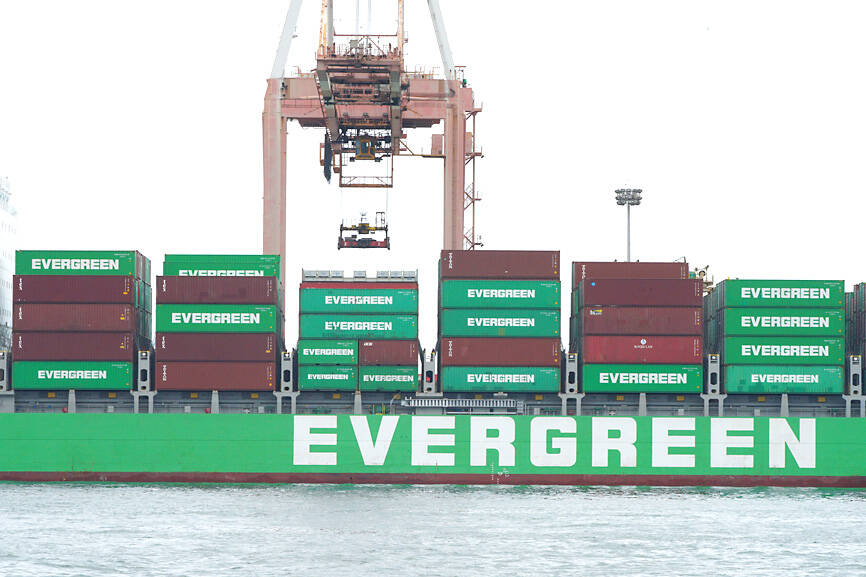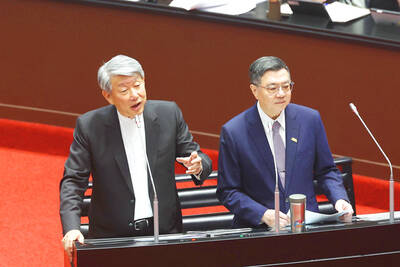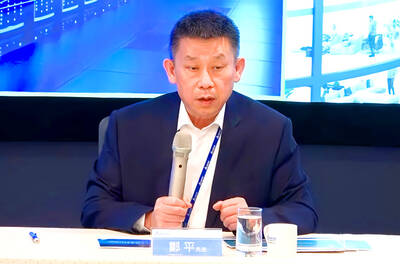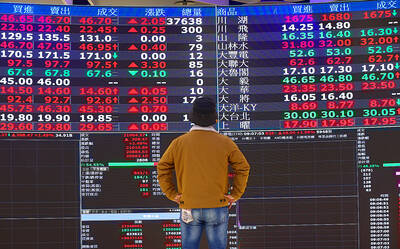Export orders last month dropped 4.6 percent year-on-year to US$52.87 billion, marking the 14th month of consecutive declines, the Ministry of Economic Affairs (MOEA) said in a report yesterday.
The decline was at the lower end of the 4.3 percent to 7.9 percent the ministry forecast a month ago, and was also lower than the 15.6 percent decrease recorded in September.
On a monthly basis, export orders — an indicator of product and component shipments to overseas markets over the following one to three months — increased for a second straight month at 2.9 percent, the ministry said.

Photo: CNA
Even though the latest data present signs of gradual improvement in export orders, the ministry remains cautious about the outlook for orders received by Taiwanese firms in the near term, the report said, citing slowing end-market demand and continued inventory adjustments as the global economy is still affected by high inflation and the spillover effect of monetary tightening by central banks, while uncertainties such as the US-China rivalry, the Russia-Ukraine war and the Israeli-Hamas conflict persist.
Last month’s figure brought combined export orders in the first 10 months of the year down 17.3 percent year-on-year to US$466.6 billion, the ministry said. This month, export orders are forecast to decrease up to 3.5 percent monthly, but increase 1.7 to 5.7 percent annually to between US$51 billion and US$53 billion, it said.
In a recent poll of domestic manufacturers by the ministry, only 15.7 percent of respondents were optimistic that export orders would increase this month from last month, while 58.2 percent said that orders would be flat from last month and 26.1 percent expected further decline, the report said.
The latest data showed export orders for information and communications technology (ICT) products last month fell 5.2 percent year-on-year, while orders for electronic goods edged down 0.3 percent from a year earlier as increased shipments of servers, graphics cards and chips were offset by slowing demand for notebook computers, networking and communications devices, printed circuit boards, and IC packaging and testing services, the report said.
Optoelectronics products last month posted a 13.8 percent annual increase as prices of flat panels rose and demand for camera lenses improved, it said.
Firms in non-tech sectors continued a downtrend amid adverse macroeconomic conditions, with orders for basic metals, machinery goods, plastics and chemical products last month shrinking from the same period last year by 5.4 percent, 12.8 percent, 6.9 percent and 11.5 percent respectively.
Last month, orders from Southeast Asia registered the largest annual increase of 94.9 percent, followed by a rise of 1.2 percent in orders from China (including Hong Kong). However, orders from Europe posted the largest annual decline of 45.8 percent, compared with a drop of 17.6 percent in orders from Japan and a 1.4 percent fall in orders from the US, the report said.
Meanwhile, 53 percent of all export orders last month received by local manufacturers were for products from overseas factories, down 2 percentage points from a year earlier, as several ICT and electronics makers moved production back to Taiwan, the report found.

Taiwanese suppliers to Taiwan Semiconductor Manufacturing Co. (TSMC, 台積電) are expected to follow the contract chipmaker’s step to invest in the US, but their relocation may be seven to eight years away, Minister of Economic Affairs J.W. Kuo (郭智輝) said yesterday. When asked by opposition Chinese Nationalist Party (KMT) Legislator Niu Hsu-ting (牛煦庭) in the legislature about growing concerns that TSMC’s huge investments in the US will prompt its suppliers to follow suit, Kuo said based on the chipmaker’s current limited production volume, it is unlikely to lead its supply chain to go there for now. “Unless TSMC completes its planned six

Intel Corp has named Tasha Chuang (莊蓓瑜) to lead Intel Taiwan in a bid to reinforce relations between the company and its Taiwanese partners. The appointment of Chuang as general manager for Intel Taiwan takes effect on Thursday, the firm said in a statement yesterday. Chuang is to lead her team in Taiwan to pursue product development and sales growth in an effort to reinforce the company’s ties with its partners and clients, Intel said. Chuang was previously in charge of managing Intel’s ties with leading Taiwanese PC brand Asustek Computer Inc (華碩), which included helping Asustek strengthen its global businesses, the company

Power supply and electronic components maker Delta Electronics Inc (台達電) yesterday said second-quarter revenue is expected to surpass the first quarter, which rose 30 percent year-on-year to NT$118.92 billion (US$3.71 billion). Revenue this quarter is likely to grow, as US clients have front-loaded orders ahead of US President Donald Trump’s planned tariffs on Taiwanese goods, Delta chairman Ping Cheng (鄭平) said at an earnings conference in Taipei, referring to the 90-day pause in tariff implementation Trump announced on April 9. While situations in the third and fourth quarters remain unclear, “We will not halt our long-term deployments and do not plan to

The New Taiwan dollar and Taiwanese stocks surged on signs that trade tensions between the world’s top two economies might start easing and as US tech earnings boosted the outlook of the nation’s semiconductor exports. The NT dollar strengthened as much as 3.8 percent versus the US dollar to 30.815, the biggest intraday gain since January 2011, closing at NT$31.064. The benchmark TAIEX jumped 2.73 percent to outperform the region’s equity gauges. Outlook for global trade improved after China said it is assessing possible trade talks with the US, providing a boost for the nation’s currency and shares. As the NT dollar